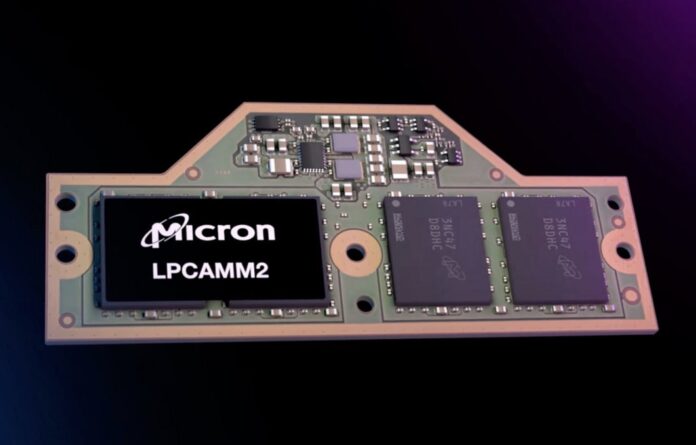Micron has a new LPCAMM2 memory module to take the throne from SODIMMs. For those wondering, LPCAMM2 is “Low Power Compression Attached Memory Module 2.” The new module is designed to offer more bandwidth at a lower power envelope and smaller footprint than SODIMMs.
Micron LPCAMM2 LPDDR5X Replacing SODIMMs
The new module uses LPDDR5X memory and can fill 128-bit memory interfaces. When we discuss SODIMM memory working in dual channel mode, it fills 128-bit memory interfaces using two 64-bit devices. As a result, the LPCAMM2 only needs a single module instead of two for maximum performance. That means lower power and a smaller physical footprint.
This year, the LPCAMM2 modules are limited to 7500MT/s for around 120GB/s of memory bandwidth. For some context, we wrapped up testing of a NVIDIA Grace Hopper platform last week and our STREAM benchmark bandwidth on the Arm CPU side with 480GB of LPDDR5X was ~325-385GB/s. Of course, more detailed numbers are coming, and that is actual memory bandwidth rather than theoretical bandwidth. Still, it gives some sense of scale. The difference with LPCAMM2 is that the modules are upgradable instead of being soldered down.
In the first generation, we get capacities of either 32GB or 64GB. That also means that compared to SODIMMs, the total capacity of systems using LPCAMM2 is going to be lower than is possible with SODIMMs, but that is really due to it being a first-generation technology.
Final Words
Of course, LPCAMM2 memory does not slot into a SODIMM slot. As a result, one needs a compatible system to use these modules. For now, this is a single Lenovo model, the ThinkPad P1 Gen 7. Even though it is memory for a single Lenovo model today, usually by the time we get an announcement, several other systems are in progress. In the meantime, Micron’s Crucial brand will be selling the modules. In many ways, this is really cool since it gives the power and performance benefits of a LPDDR5X memory subsystem while making it modular.





The article acknowledges the limitations of current LPCAMM2 bandwidth compared to high-end systems. However, it highlights the upgradeability advantage of LPCAMM2 over soldered memory.
I’m looking forward to this being a common option on laptops, where it could save the Mfgs costs of stocking identical system boards with different RAM and give the consumer back the ability to upgrade/repair.